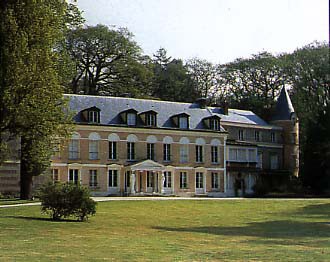Following his article against Napoleon which had appeared in the Mercure in 1807, Chateaubriand, victim of imperial censorship, was forced to move out of at least two houses in Paris. However, thanks to the success of his earlier publications, Atala and Le Génie du Christianisme, he was able to afford a modest property located in a green valley to the south of Paris, a property lovingly described on the first page of his monumental Memoires d'Outre-tombe: “Four years ago, on my return from the Holy Land, I bought a gardener's house, hidden amongst the wooded hills not far from the hamlet of Aulnay, in the region of Sceaux and Châtenay. The uneven and sandy land behind this house was no more than a wild orchard, at the end of which there was a ravine and a thicket of chestnut trees. This small space seemed to me an appropriate enclosure for my long enduring hopes: spatio brevi spem longam reseces.”
Chateaubriand then transformed the house into a romantic retreat and lived there for ten years: “I made a few additions to my cottage, I embellished its brick façade with a pediment supported by two white marble columns: it reminds me that I once passed through Athens. My project was to add a tower; but in the meantime, I have put fake crenelations in the wall that separates me from the road; I was thus in advance of the mania for the Medieval which so inspires people today.” He also introduced one of the first examples of the 'troubadour style' in France by installing Gothic windows. Inside the house, the principal transformation was the double flight of stairs, built “to accommodate flowers”. Chateaubriand and his wife, Celeste, also transformed the orchard into a vast and magnificent park destined to receive rare species recalling the the writer's voyages: Armorican oaks, American bald cypresses, Greek plane trees, Lebanese cedars and Jerusalem pines. Paradoxically, it was the Empress Josephine who gave them a good many small shrubs, most notably, a magnolia with crimson flowers, the only specimen, other than the one at Malmaison, known in France. Of his trees in the Vallée-aux-Loups, Chateaubriand said that they were his only family and that he wished to die beside them.
In this haven of solitude, withdrawn in the Velleda Tower at the back of the park, the writer wrote parts of various works, notably: L'Itinéraire de Paris à Jérusalem, Martyrs, Les Aventures du Dernier des Abencerage, Moïse (Moses), and, above all, the first chapters of the Memoires d'Outre-tombe. There he received a number of visitors: Joubert, Fontanes, Pasquier, Molé, Bertin and the Countess de Boigne or the Duchess de Duras. The young Lamartine scaled the wall of the property in order to see the great man, and legend has it that Napoleon went there incognito during when Chateaubriand was not there.
Following financial difficulties in 1816, Chateaubriand was first forced to sell his library, then, in 1818, his dear valley was acquired by Mathieu de Montmorency. The “Vallée-aux-Loups,” he would write later, “of all of the things that escaped me, is the only one that I miss.” In 1826, the property was rented to Madame Récamier who spent many summers there surrounded by her circle of admirers. Chateaubriand visited her on many occassions.
Staying in the possession of the Rochfoucault family until 1914, the estate was then purchased by the doctor Le Savoureux who installed there the seat of the Chateaubriand Society, created in 1929. Listed as an Historic monument in 1939, the site was acquired in 1970 by the Hauts-de-Seine Department which, in collaboration with the Ile-de-France Regional Council, contributed to its reorganization. A excellent restoration has brought back the Romantic feel of the dwelling. Visitors can admire there a number of documents on Chateaubriand and a collection of splendid furniture from the epoch, among which is the chaise longue on which Madame Récamier posed for the famous painting by David.
In addition to being a museum, the house is also the site of a library and a Research Centre for Romanticism. Since 1987, the lively cultural life of the estate has been marked by the award of an history prize every November, an Heures Musicales concert season in spring and autumn, and temporary exhibitions and literary conferences.
Home of Chateaubriand – La Vallée-aux-Loups


